| کد مقاله | کد نشریه | سال انتشار | مقاله انگلیسی | نسخه تمام متن |
|---|---|---|---|---|
| 609532 | 880625 | 2010 | 11 صفحه PDF | دانلود رایگان |

A discrete population balance model is derived in order to investigate nanoparticle precipitation inside droplets of a water-in-oil microemulsion. Special attention is being paid to the droplet exchange. This mechanism is responsible for the mixing of the reactants before precipitation starts. Thus, a very precise determination is important for the subsequent steps nucleation and growth which depend on the supersaturation being a function of the reactant concentrations inside the droplets. For a reliable evaluation of the droplet exchange a bivariate population balance for the two dissolved reactants and a one-dimensional population balance comprising the particle size has been formulated. The coalescence and redistribution of the droplets is described by a two-dimensional agglomeration-type term. Different bivariate kernel functions for a situation with the low soluble product BaSO4 and its two reactants BaCl2 and K2SO4 have been analyzed within this term. In conclusion, it was found that a kernel with a linear profile for the attractive forces between the two reactants fits experimental findings best. It takes into account that the redistribution of two merged mother droplets is different for the case that only one of the two reactants exists in the merged droplets and the case that a satisfactory amount of both reactants to form a stable nucleus appears inside them. An equal redistribution in the daughter droplets happens in the first case and an accumulation inside one daughter droplet in the second case. Intermediate states are obtained by the linear profile of the kernel function between these two limiting cases.
A multidimensional population balance model, which describes exchange of salt ions during coalescence and redispersion of microemulsion droplets, gives a deeper insight into the microkinetics of aggregation in multi-component systems.Figure optionsDownload as PowerPoint slide
Journal: Journal of Colloid and Interface Science - Volume 342, Issue 2, 15 February 2010, Pages 361–371